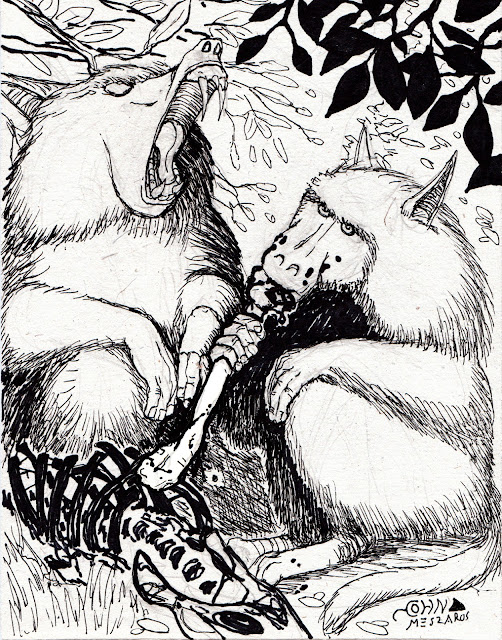Though South America, Central America and southern Mexico have
a great diversity of primates, northern North America has none aside from
humans. This is ironic given that the earliest known primate- a small,
squirrel-like creature called Purgatorius- evolved on this continent. Descendants of Purgatorius and its
relatives diversified into several lineages of tarsier- and lemur-like forms
that inhabited North America during the warm Eocene epoch before supposedly dying
out as the land grew cooler and grasslands became more abundant.
A fossil find in 1960s altered this view when molars from a
lemur-like creature dubbed Ekgmowechasala (Sioux for “Little Cat Man”)
were unearthed on the Pine Ridge Indian Reservation in South Dakota. This animal
lived in the Oligocene, millions of years after other primates were thought to
have died out, proving that at least a few of these lines had continued. Though
no younger North American primate fossils have been found since, what if descendants
of Ekgmowechasala survived into the present day?
In 1959 a couple by the name of Boyd were driving home near
Saltville, Virginia when a strange, monkey-like beast attacked their car. They
described it as having light “taffy-colored” fur with a white belly, and
powerful, muscular legs. Other people in the Saltville area reported seeing a
similar creature around the same time.
Then in the 1990s a woman driving on a dark Virginia backroad
saw a creature run in front of her car that she described as black and sleek
with a long tail, pointy ears, a short-snouted face, a man-like torso, and
powerful hind legs. Though the earlier Boyd cryptid bears little resemblance to
this animal- and may in fact have been a different species- both incidents have
been conflated in pop culture as encounters with what have come to be called devil
monkeys.
While the Virginia encounters are the most well-known
sightings, devil monkeys have been seen throughout North America. Coweta County, Georgia, for example, is
haunted by the Belt Road Booger, a simian creature with a “flat, beaver-like
tail covered in hair”. Run-ins with the Booger began in the 1970s, many of them
now believed to have been hoaxes by pranksters dressed in gorilla costumes. But
other encounters have not yet been fully explained. The Belt Road Booger has
become such a local sensation that a taxidermist in Newnan, Georgia even made a
fake “Booger” head out of a white-tailed deer’s posterior as a decoration for a
friend’s hardware store.
There is also possible photographic evidence of a devil
monkey. In 1996 photos surfaced online of a strange, furry, baboon-like carcass
lying along the curb of a Louisiana highway. Dubbed the Deridder Roadkill, the
body bears a distinct resemblance to descriptions of these cryptids with its
long snout, bushy-haired body, and ape-like feet. While some have suggested the
carcass was a devil monkey, others have proposed that it could be a rougarou,
dogman, or even a chupacabra. More mundane suggestions include a large Pomeranian
dog, or even a prop. However, as so often happens in these cases, the body
disappeared before samples could be taken, so its identity could not be proved
definitively.
Devil monkeys are often said to have powerful kangaroo-like
hind legs that allow them to jump huge distances. This feature has led some cryptozoologists
to wonder if widely reported “phantom kangaroos” sighted throughout the US and
Canada might actually be these animals.
While stories of large non-human North American primates
like sasquatch and skunk apes are abundant in folklore and cryptozoology, no fossil
evidence for these creatures has been found. Thus if they are real, one could
argue that they likely migrated to this continent late in geological history along
the same routes that humans used. Devil monkeys, on the other hand, may
represent a species of home-grown North American primate possibly descended from
Ekgmowechasala or similar animals.
REFERENCES
Eons.
(20, November 12). What happened to primates in North America? [Video]. PBS.org.
https://www.pbs.org/video/the-first-and-last-north-american-primates-dztigm/#:~:text=Why%20don't%20we%20have,and%20eventually%20they%20all%20disappeared.
Gilly,
Steve. (2018, April 20). The Devil Monkey. MountainLore. https://mountainlore.net/2018/04/20/the-devil-monkey/
Grundhauser,
Eric. (2016, December 22). Does America have a secret kangaroo population? Atlas
Obscura. https://www.atlasobscura.com/articles/does-america-have-a-secret-kangaroo-population
Leftwich,
Rebecca. (2023, October 30). Who put the “boo” in the Belt Road Booger? The
Newnan Times-Herald. https://www.times-herald.com/news/who-put-the-boo-in-the-belt-road-booger/article_ee9d689e-770f-11ee-a003-8bb851ca9cb4.html
Lynch,
Brendan M. (2023, November 6). Fossils tell tale of last primate to inhabit North
America before humans. University of Kansas. https://news.ku.edu/2023/11/06/fossil-evidence-tells-tale-last-primate-inhabit-north-america-humans#:~:text=The%20first%20primates%20came%20to,about%2034%20million%20years%20ago.
Morphy,
Rob. (2010, January 13). Deridder Roadkill: (Louisiana, USA). Cryptopia. https://www.cryptopia.us/site/2010/01/deridder-roadkill-louisiana-usa/
Morphy,
Rob. (2010, December 6). Devil monkeys: (North America). Cryptopia. https://www.cryptopia.us/site/2010/12/devil-monkeys-north-america/
Spooky
Appalachia. (2023, April 26). The story of the Virginia devil monkey. [Video].
YouTube. https://www.youtube.com/watch?v=Nsv-mBSEX74
Taylor,
Jr. L. B. (2012). Monsters of Virginia. Stackpole Books.

No comments:
Post a Comment